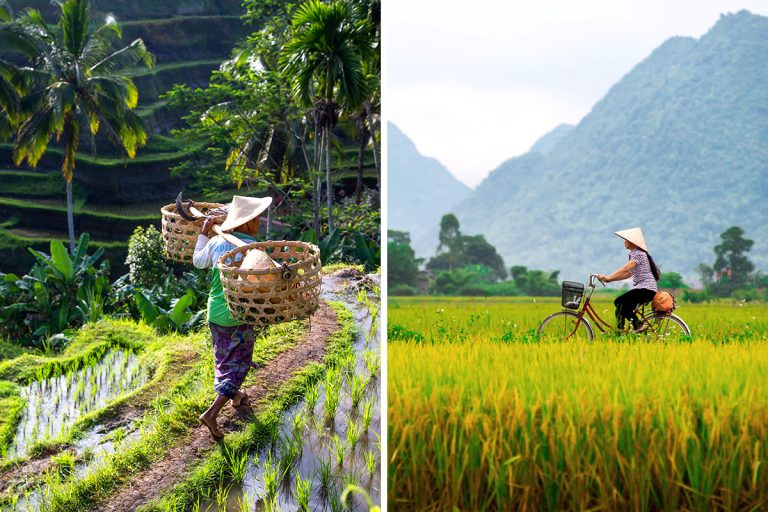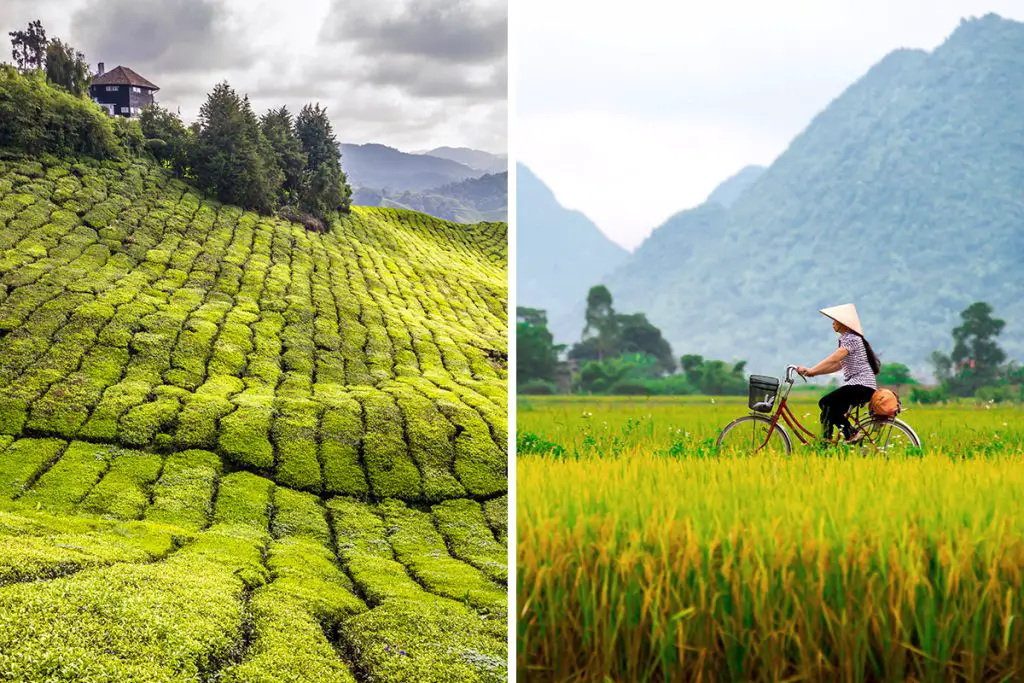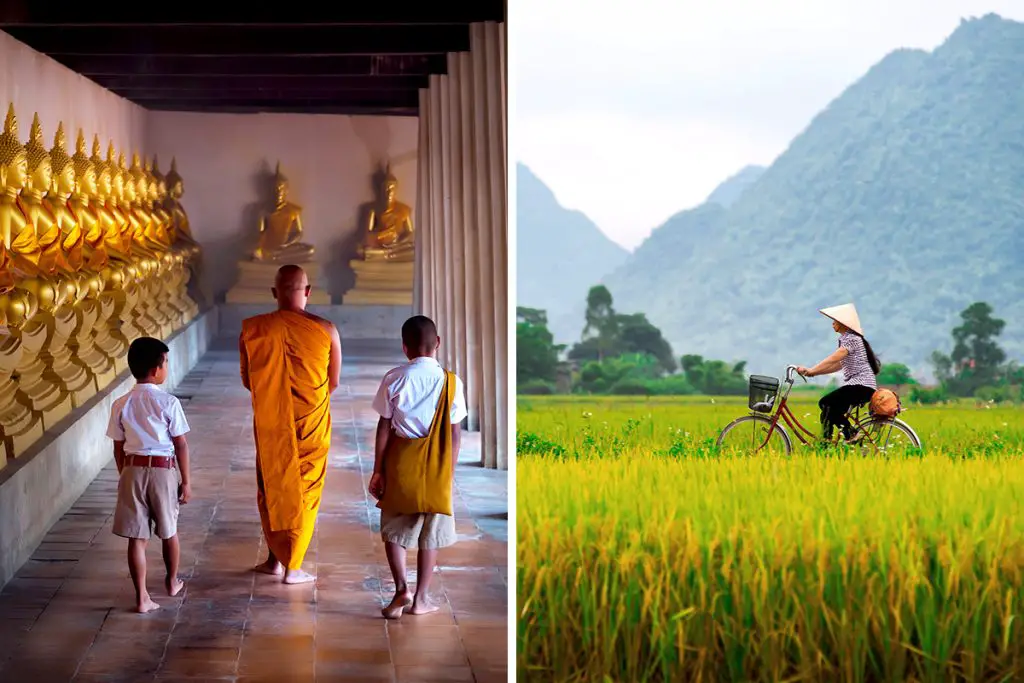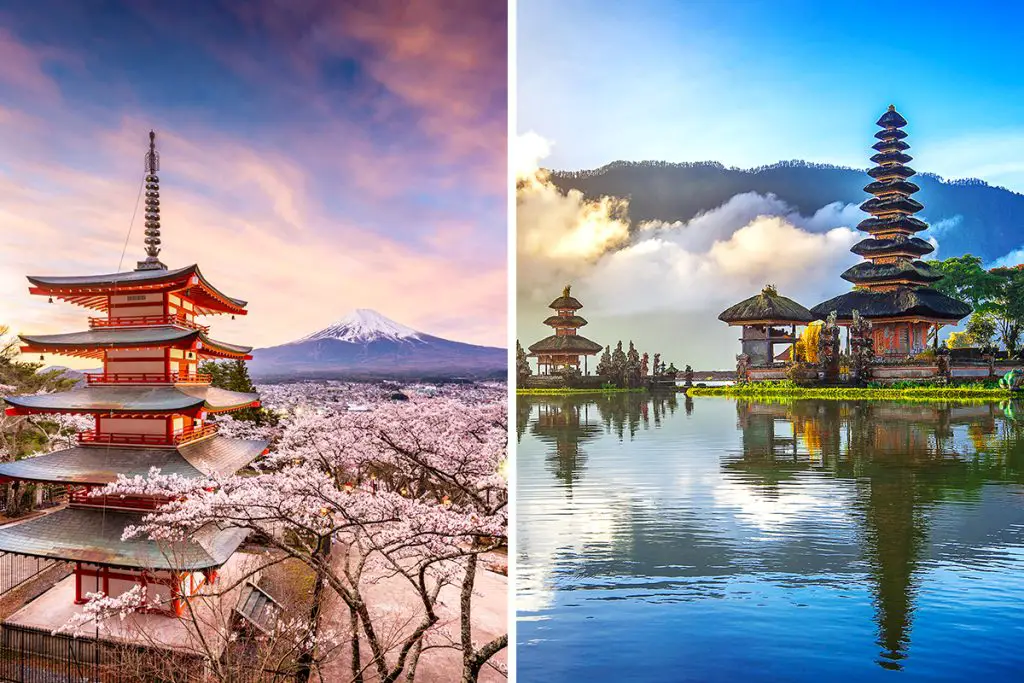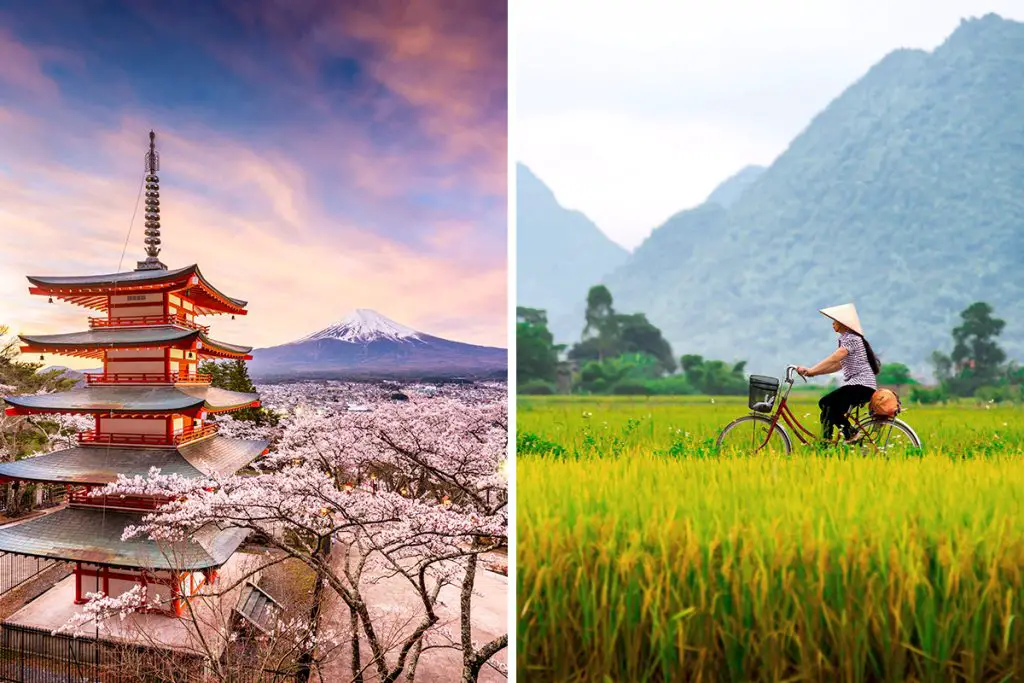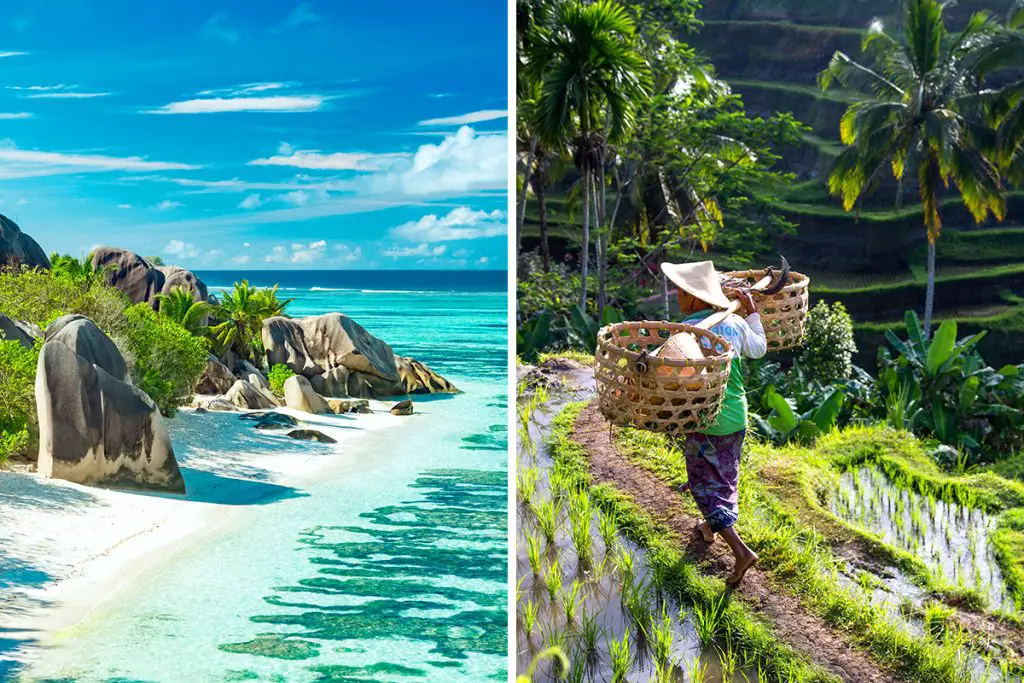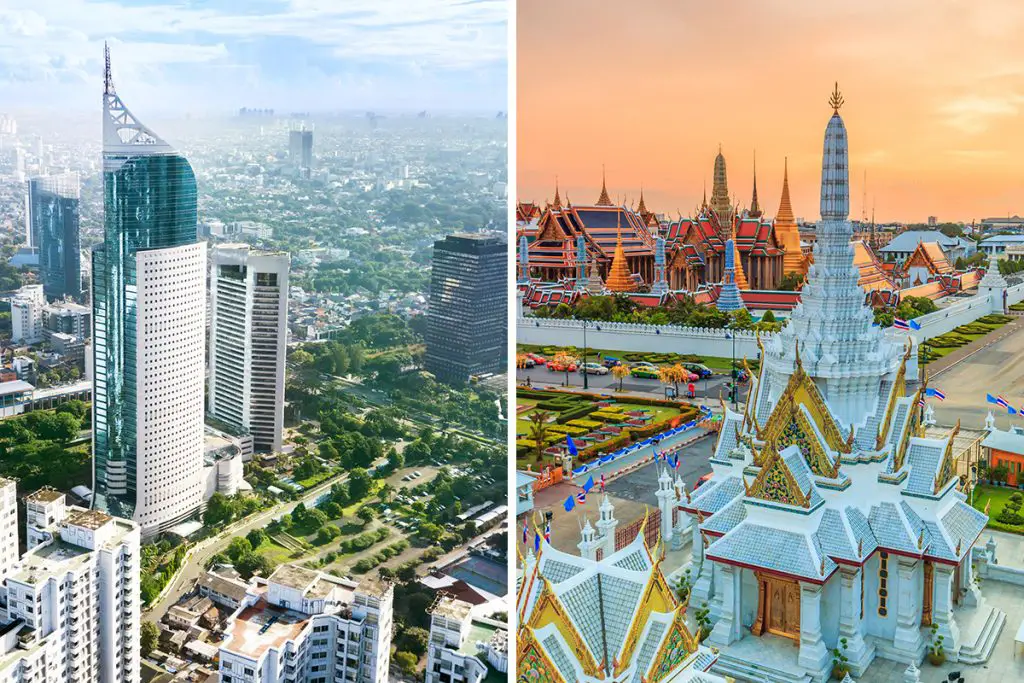Picture yourself stepping into a mesmerizing land of temples, or imagine walking through buzzing streets imprinted with the footprints of time. Whether it’s the spirituality that Bali emanates or the rich past that Vietnam radiates, both destinations are packed with unique allure. Are you ready to dive deep into the historical and cultural nuances of these intriguing places?
History & Culture
History and culture are like threads woven into the fabric of a destination, adding color and texture. They’re the soul of the place, visible in its architecture, customs, and the stories the locals tell. Now, let’s look at the historical and cultural aspects of Bali and Vietnam.
Bali, an island in Indonesia, has a history that stretches back over 2000 years. Ancient kingdoms, diverse ethnicities, and varied religious influences have shaped Bali’s unique culture. Its historical tapestry is rich with Hindu-Buddhist traditions, royal dynasties, and influences from Dutch colonial times.
As you traverse Bali, you’ll feel a deep sense of spirituality and artistic beauty embodied in every temple, every ritual, and every dance performance.
Vietnam, nestled on the eastern edge of the Indochina Peninsula, tells a different story. Its history, spanning over 4000 years, is marked by periods of Chinese, French, and American occupation, interspersed with fierce struggles for independence.
This has given Vietnam an incredibly resilient and multi-faceted culture. From its folk music echoing stories of the past, to the charming blend of architectural styles, Vietnam narrates a compelling tale of cultural synthesis and survival.
Comparing Bali and Vietnam is like contrasting a serene painting with a pulsating melody. Bali is characterized by a tranquil, spiritual aura, while Vietnam exhibits a lively cultural dynamism. Both are rich in history and culture, yet their expressions are beautifully diverse.
However, there isn’t a clear ‘better’ or ‘worse’ between the two. Bali might appeal to those seeking a peaceful, spiritual retreat steeped in tradition, whereas Vietnam might attract those yearning for a vivid, immersive cultural experience packed with historical layers.
To summarize, Bali and Vietnam are two compelling destinations, each boasting a rich history and vibrant culture. Will you choose the tranquil spiritual charm of Bali, or would you prefer the dynamic cultural tapestry of Vietnam? That’s a decision only you can make.
Attractions & Activities
Attractions and activities in a destination breathe life into your travel experience. They shape your journey, offer memorable moments, and create the stories you’ll share when you return home. As we explore the attractions and activities of Bali and Vietnam, you’ll find that each offers a unique set of experiences.
In Bali, your adventure might begin at the Pura Tanah Lot, an iconic sea temple that sits majestically on a rock formation off the coast. You could immerse yourself in a soothing yoga retreat, or perhaps trek up Mount Batur at dawn, greeting the sun as it illuminates the stunning landscape.
And for the art enthusiasts, Ubud, the cultural heart of Bali, with its art markets, museums, and studios, is a paradise waiting to be discovered.
Over in Vietnam, the attractions promise a different flavor of excitement. In the capital city of Hanoi, you could stroll around Hoan Kiem Lake, stopping at Ngoc Son Temple for a dose of tranquility amidst the urban buzz. Venturing into Ho Chi Minh City, the War Remnants Museum and the Independence Palace offer glimpses into the country’s tumultuous past.
For nature enthusiasts, a boat tour through the emerald waters of Halong Bay, dotted with limestone karsts, is an experience not to be missed.
In essence, the attractions in Bali revolve around its natural beauty and spiritual heritage, offering a tranquil and reflective journey. Vietnam, meanwhile, presents a blend of historical sites, bustling cities, and breathtaking natural vistas, serving up a dynamic and diverse experience.
Both Bali and Vietnam offer captivating attractions and activities, but they cater to different tastes. If you’re seeking peace, spirituality, and a slower pace of life, Bali has your name on it. For those craving a vibrant mix of history, city life, and nature, Vietnam is calling. Your choice depends on the type of traveler you are!
Beaches
Nothing quite compares to the feel of warm sand beneath your feet and the sight of endless waves lapping at the shore. A destination’s beaches often become the highlight of a trip for many travelers. Now let’s dive into the sands of Bali and Vietnam.
Bali’s beaches are famous worldwide, each one unique in its own right. Kuta Beach, for instance, is popular among surfers, with waves reaching as high as 6 feet (about 1.8 meters). Seminyak Beach, about 4 miles (6.4 kilometers) away from Kuta, is renowned for its spectacular sunsets that color the sky in hues of orange and pink.
For a serene and less crowded beach experience, you could head to Sanur Beach, located 7 miles (about 11.3 kilometers) from Seminyak.
Vietnam, on the other hand, offers an extensive coastline dotted with beaches that are lesser known but just as enchanting. The crescent-shaped Nha Trang Beach, about 275 miles (442 kilometers) from Ho Chi Minh City, boasts clear turquoise waters ideal for snorkeling.
Further north, about 326 miles (525 kilometers) from Nha Trang, is Da Nang Beach, which offers an unspoiled sandy stretch perfect for long, peaceful walks.
In a nutshell, Bali’s beaches are characterized by their vibrant beach life and breathtaking sunsets, offering a lively and captivating experience. Vietnam’s beaches are less commercialized, providing tranquil spaces for relaxation and a more laid-back beach experience.
Choosing between Bali’s lively, renowned beaches and Vietnam’s tranquil, unspoiled stretches of sand comes down to your preference. Are you longing for a vibrant beach scene, or do you crave serene, untouched shores? The choice is in your hands.
Eating, Drinking & Nightlife
Food, drink, and nightlife contribute significantly to the overall travel experience, adding flavors and rhythms to your journey. As you explore the culinary scene and after-hours excitement in Bali and Vietnam, you’ll find each destination is a feast for the senses in its own right.
In Bali, the dining experience is as diverse as the island itself. From roadside warungs offering traditional dishes like nasi goreng (fried rice) and satay, to high-end restaurants serving international cuisine, there’s a plate for every palate. For a truly unique experience, try a Balinese cooking class where you can learn to create these local delights yourself.
Vietnam’s culinary landscape is a mix of flavors and textures, with dishes like pho (noodle soup), banh mi (sandwiches), and spring rolls delighting taste buds in street stalls and local eateries alike. For foodies interested in Vietnamese cuisine, joining a street food tour in cities like Hanoi or Ho Chi Minh is a must-do.
When it comes to drinks, Bali’s offerings range from tropical cocktails to local wines made from rice and fruits. Don’t forget to try Bali’s coffee, known for its strong, rich flavor.
Alternatively, Vietnam is famous for its local beers, which are served chilled and often enjoyed street-side in the evenings. Also, Vietnamese coffee, usually served with condensed milk, is an experience in itself.
As the sun sets, Bali transforms into a vibrant playground. Beach clubs and bars in areas like Kuta and Seminyak offer live music, dance floors, and seaside views. In contrast, Vietnam’s nightlife scene is a mix of old and new, with modern rooftop bars offering stunning city views and traditional water puppet shows captivating audiences.
In summary, Bali offers a diverse food scene, refreshing drinks, and a lively beach-centered nightlife. Vietnam entices with its flavorful street food, local beers, and a varied nightlife that mixes traditional and modern experiences. The choice comes down to your personal preferences.
Shopping
Shopping can be an exciting part of any trip, offering you the chance to explore local markets, discover unique finds, and take home a piece of your journey. As you navigate the shopping scenes of Bali and Vietnam, you’ll find plenty of opportunities to indulge your inner shopaholic.
Bali is a treasure trove for shoppers, particularly in artsy Ubud. Here, local markets brim with handcrafted jewelry, wooden sculptures, and traditional batik fabrics. For a unique souvenir, consider purchasing a Balinese mask, each one meticulously hand-painted and unique. In Seminyak, upscale boutiques offer everything from designer wear to high-quality homewares.
In Vietnam, shopping is an adventure in cultural immersion. In the bustling markets of Hanoi and Ho Chi Minh City, you can find everything from traditional silk fabrics and hand-embroidered items to lacquerware and ceramics.
Be sure to check out the local art scene, especially in Hanoi, where galleries showcase stunning works of art, from traditional Vietnamese silk paintings to modern contemporary pieces.
In conclusion, whether it’s Bali with its artsy markets and unique handicrafts, or Vietnam with its vibrant local markets and rich selection of traditional goods, each offers a unique shopping experience. Which one appeals to you more? The choice is yours to make!
Accommodation
Finding the perfect place to stay is an integral part of any trip. Both Bali and Vietnam provide an array of accommodations to suit various tastes and budgets, from luxury resorts to budget-friendly guesthouses.
In Bali, you can experience the height of luxury in world-class resorts dotting the coastline, particularly in areas like Seminyak and Nusa Dua. For a unique stay, consider a private villa nestled amidst the lush rice terraces of Ubud. Budget-conscious travelers can find a host of affordable yet comfortable homestays, perfect for soaking up local culture.
Contrastingly, Vietnam offers a broad spectrum of accommodations. In major cities like Hanoi and Ho Chi Minh, you can opt for modern hotels featuring a blend of Eastern and Western designs. Quaint guesthouses located in the ancient town of Hoi An or the mountains of Sapa offer a more traditional and cozy experience.
Also, Vietnam is known for its affordable hostels, making it a great choice for backpackers.
In a nutshell, Bali’s accommodation options lean towards luxury and tropical charm, while Vietnam provides a range of choices from city-based hotels to homely guesthouses. Where would you like to rest your head at night?
Family-Friendliness & Children’s Activities
Traveling with family, especially with kids, requires careful planning to ensure fun and safety for all. Bali and Vietnam both boast a range of family-friendly destinations and activities that promise memorable experiences for everyone.
In Bali, the Bali Safari And Marine Park provides a fun-filled day with its exciting safari tours and water rides. Visit the interactive eco-park Green School in Ubud, where kids can learn about sustainability while having fun. Bali’s beach clubs often have dedicated kids’ sections, so you can relax while the little ones play safely.
Vietnam also has plenty to offer younger travelers. In Hanoi, the Museum of Ethnology features engaging exhibits and outdoor play areas that kids will love. The Vinpearl Amusement Park in Nha Trang is a fun-filled destination with rides, water parks, and an aquarium. A boat trip along the Mekong Delta offers an interactive way for kids to learn about local life.
Summarily, both Bali with its mix of outdoor activities and educational experiences, and Vietnam with its engaging museums and amusement parks, make for fantastic family-friendly destinations. Which one will your family love more?
Getting There & Getting Around
Travel logistics, including getting to your destination and exploring locally, are key aspects of any travel plan. Whether you choose Bali or Vietnam, it’s crucial to understand your transport options.
Reaching Bali typically involves flying into Ngurah Rai International Airport, about 8 miles (approximately 13 kilometers) south of Denpasar, the island’s capital. Direct flights are available from many international cities.
On the other hand, Vietnam has several international airports, with Noi Bai in Hanoi and Tan Son Nhat in Ho Chi Minh City being the major ones. Direct flights to Vietnam are available from select locations worldwide.
Once in Bali, taxis and hired drivers are common ways to get around. Alternatively, renting a motorbike is popular among travelers, but remember to drive safely! Bicycles are also a viable option, particularly in quieter areas like Ubud.
In Vietnam, taxis and ride-hailing services like Grab are prevalent in cities. For shorter distances, cyclos (three-wheeled bicycle taxis) are a unique, albeit slower, mode of transport. Intercity travel is commonly done by train or bus.
To conclude, both Bali and Vietnam offer fairly straightforward travel logistics with a variety of local transportation options. Would you prefer zipping around on a motorbike in Bali or navigating Vietnam’s streets in a cyclo? It’s all part of your unique travel adventure!
Weather
Your vacation experience can greatly be influenced by the weather, making it a crucial factor when planning your trip. Here’s a rundown of the typical weather patterns in Bali and Vietnam to guide your travel decisions.
Bali enjoys a tropical climate with two distinct seasons: the dry season from April to October, and the rainy season from November to March. Temperatures remain fairly consistent throughout the year, averaging around 80°F (27°C). You’ll find the dry season is the best time to explore Bali’s beaches and outdoor attractions.
Vietnam, on the other hand, is characterized by a complex climate due to its elongated geography. In the north, like in Hanoi, there are four seasons, with hot, humid summers (June to September) and cool, dry winters (December to February).
Southern Vietnam, including Ho Chi Minh City, experiences a tropical climate with a rainy season from May to November and a dry season from December to April. Temperatures here typically hover around 82-95°F (28-35°C).
In essence, both destinations offer year-round warmth. However, the timing of the rainy and dry seasons in Bali and Vietnam might sway your decision on the best time to visit.
Safety
Safety is paramount when choosing a travel destination. Both Bali and Vietnam are generally considered safe for tourists, but each has unique considerations.
In Bali, petty theft like pickpocketing can occur, especially in crowded tourist areas. It’s important to keep your belongings secure at all times. Another unique safety concern in Bali is the presence of active volcanoes. Always heed local advice regarding volcanic activity and safe distances.
Vietnam also has low levels of serious crime, but you should still watch out for petty theft. It’s also worth noting that traffic in major cities like Hanoi and Ho Chi Minh City can be chaotic. If you’re not used to the traffic patterns, it’s safer to use taxis or rideshare services rather than attempting to drive yourself.
In summary, both Bali and Vietnam are relatively safe destinations, but keeping vigilant about your belongings and staying aware of local conditions can ensure a trouble-free vacation.
Cost
Budgeting is an important part of travel planning. Here’s a look at how your wallet might fare in Bali versus Vietnam.
In Bali, you can expect to pay around 50,000 IDR (approximately $3.50) for a local meal. A night in a budget guesthouse could cost around 150,000 IDR ($10), while luxury resorts start from 1,000,000 IDR ($70) per night. Transportation costs are variable, but a short taxi ride generally won’t exceed 70,000 IDR ($5).
Vietnam is also a budget-friendly destination. A meal at a local restaurant can cost around 50,000 VND (approximately $2.20), while a night in a budget hotel can range from 200,000 VND ($8.50). For luxury hotels, prices start from 1,500,000 VND ($65). As for transportation, a short taxi journey usually costs about 100,000 VND ($4.30).
All in all, both Bali and Vietnam are affordable travel destinations. Your final budget will ultimately depend on your travel style and the level of luxury you prefer. Now, where will your travel funds take you?
Which Is Better – Bali or Vietnam?
Deciding between Bali and Vietnam is like choosing between two different flavors of the same delightful treat. Both offer enchanting experiences yet with distinct twists that make each destination uniquely appealing.
When it comes to history and culture, Bali’s centuries-old temples and deep-rooted traditions offer an immersive experience. Vietnam, with its intricate blend of Southeast Asian, Chinese, and French influences, serves as a grand stage for cultural discovery. If you are keen on stepping back in time, the ancient historical sites of Vietnam might be your preferred choice.
For adventure seekers, Bali stands out with its thrill-seeking water sports and jungle treks. Yet, Vietnam doesn’t fall short with its bustling city life, serene countryside bike rides, and memorable cave explorations. If your idea of an activity-filled vacation leans more towards nature and adventure, Bali should top your list.
Bali is undeniably the go-to destination for beach lovers with its pristine sands and turquoise waters. Vietnam, while offering some nice coastal escapes, is better known for its dramatic landscapes than its beaches. So, if basking on a sun-drenched beach is a top priority for you, Bali has your name written all over it.
Eating, drinking, and nightlife bring forth the pulsating heart of both destinations. Bali draws food lovers with its flavorful cuisine and vibrant nightlife scene. Vietnam is equally compelling, with its street food culture and lively beer scenes. Yet, if nightlife is high on your agenda, Bali’s renowned party spots might be the deciding factor.
Shopping enthusiasts can find treasures in both places. Bali, with its array of artisan crafts and homeware, is perfect for unique souvenirs. Vietnam offers a vast selection of custom-tailored clothes and locally made handicrafts. If you’re searching for distinctive fashion items, Vietnam’s custom tailoring services might just tip the balance in its favor.
Accommodations in both destinations cater to a variety of budgets, offering everything from budget guesthouses to luxury resorts. However, family-friendliness and children’s activities seem to be more prominent in Bali, making it a more attractive choice for family vacations.
In terms of getting there and around, both destinations have well-connected international airports and offer a range of local transportation options. Bali might have a slight edge for travelers who prefer navigating by taxis or rental cars, while Vietnam’s train travel offers a different kind of experience.
When we talk about weather, Bali offers more predictability with its consistent tropical climate, whereas Vietnam’s weather can vary greatly from north to south. If you prefer predictability and year-round warmth, Bali is your best bet.
In terms of safety, both destinations are generally safe with low crime rates. Unique considerations like Bali’s active volcanoes or Vietnam’s chaotic traffic can be managed with caution and local advice.
Cost-wise, both Bali and Vietnam are affordable travel destinations. Your decision might boil down to whether you’re more inclined towards enjoying luxurious resorts in Bali or relishing the rich street food culture in Vietnam.
In the end, the choice between Bali and Vietnam depends largely on what you value most in your travel experience. Whether it’s the allure of Bali’s beaches and spiritual charm or the cultural depth and diverse landscapes of Vietnam, you’re in for an unforgettable journey.

